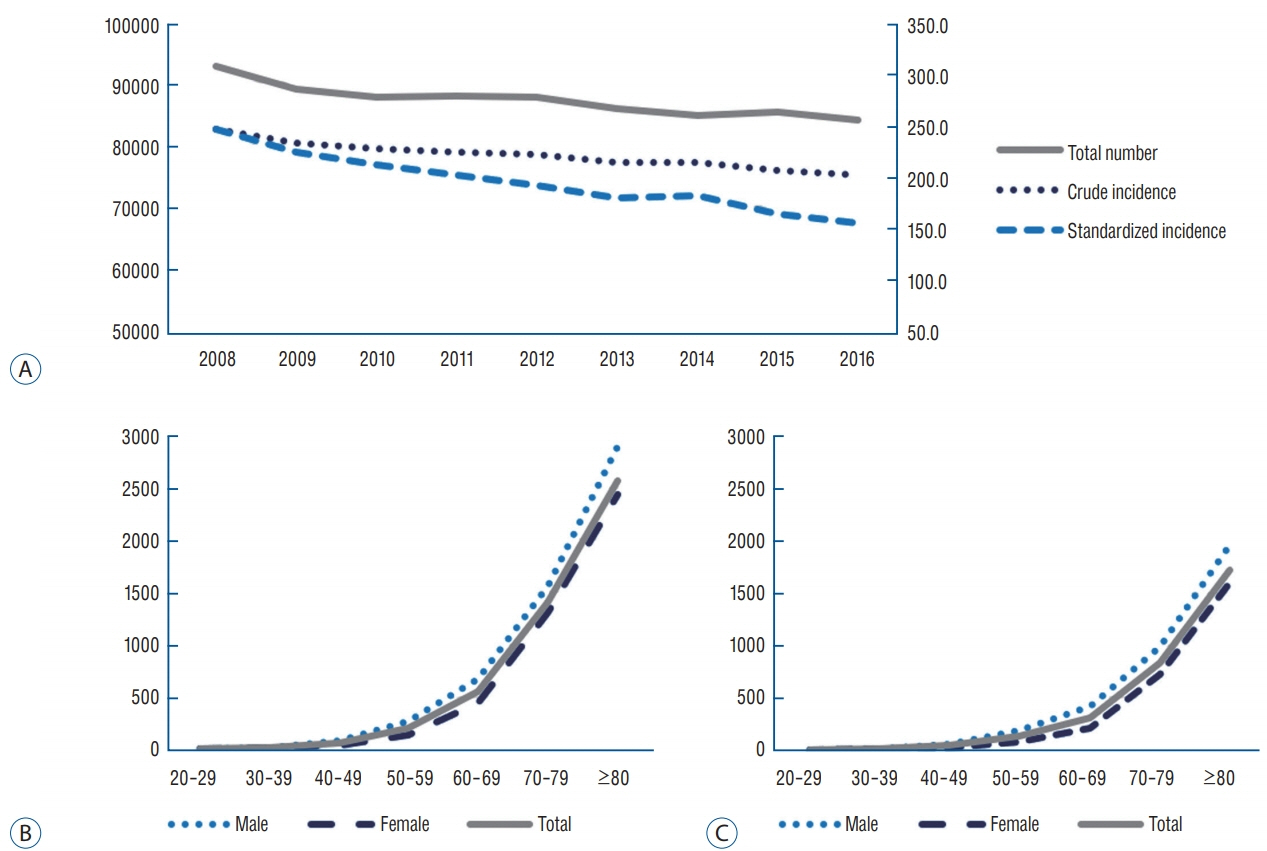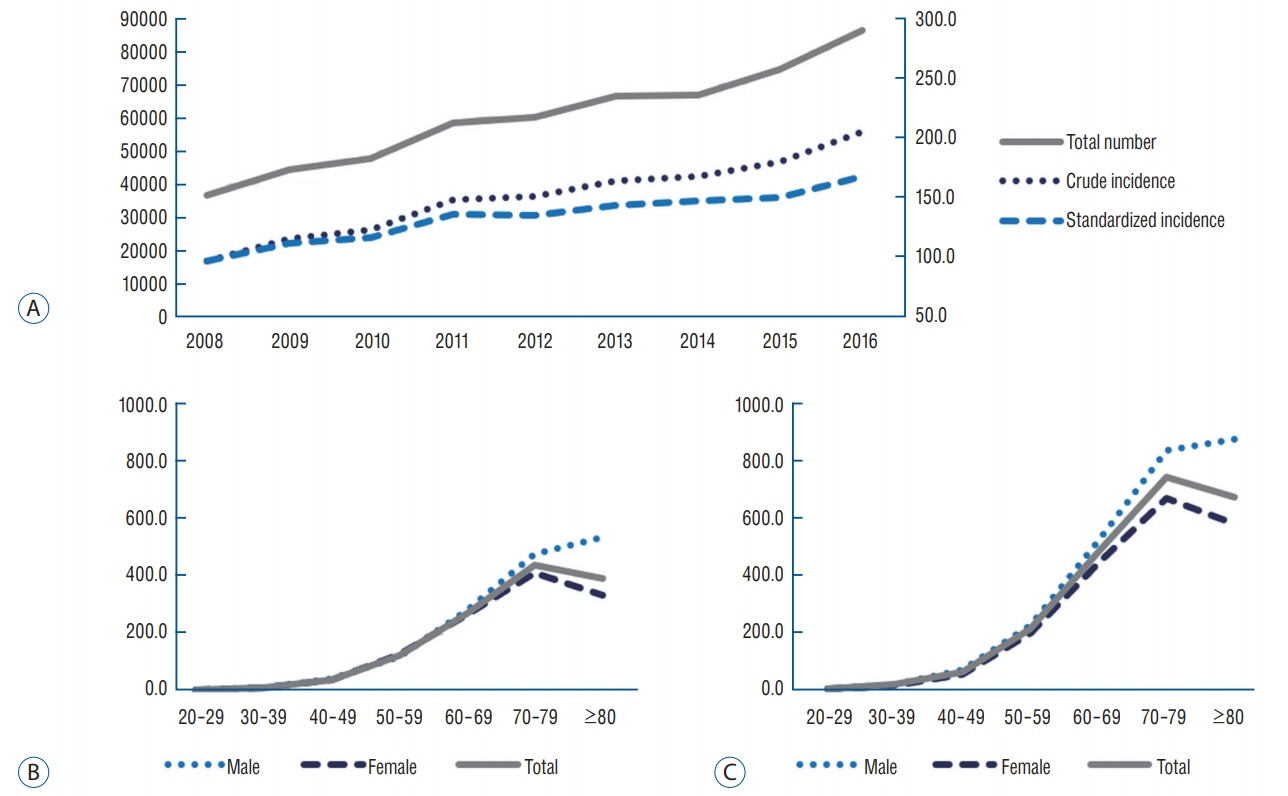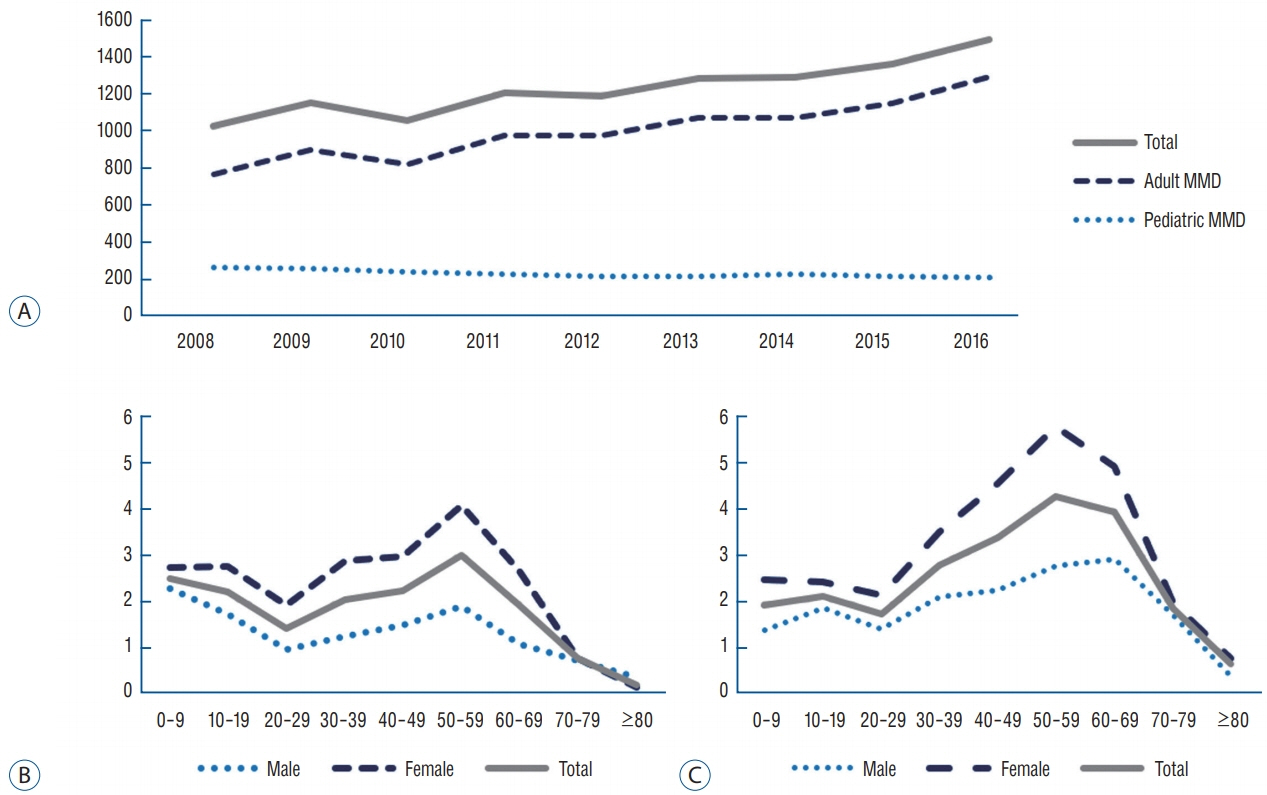J Korean Neurosurg Soc.
2020 Jan;63(1):69-79. 10.3340/jkns.2018.0182.
Trends in the Incidence and Treatment of Cerebrovascular Diseases in Korea : Part II. Cerebral Infarction, Cerebral Arterial Stenosis, and Moyamoya Disease
- Affiliations
-
- 1Department of Neurosurgery, Seoul National University Bundang Hospital, Seongnam, Korea
- 2Department of Neurosurgery, Seoul National University College of Medicine, Seoul, Korea
- KMID: 2501694
- DOI: http://doi.org/10.3340/jkns.2018.0182
Abstract
Objective
: To analyze trends in the incidence and treatment of diseases associated with ischemic stroke, namely, cerebral infarction (CI), cerebral arterial stenosis (CASTN), and moyamoya disease (MMD), based on Korean National Health Insurance Service (NHIS) data from 2008 to 2016.
Methods
: Data was extracted from the national health-claim database provided by the NHIS for 2008–2016 using International Classification of Diseases codes. The crude and age-standardized incidences of each disease (CI, CASTN without a history of CI, and MMD) were calculated; additional analyses were conducted according to age and sex. Trends in the number of patients undergoing treatment according to treatment method were analyzed for each disease using the Korean Classification of Diseases procedure codes.
Results
: In 2016, the total number of adults with newly diagnosed CI was 83939, reflecting a 9.4% decrease from that in 2008. The agestandardized incidence of CI in adults was 153.2 per 100000 person-years in 2016, reflecting a 37.2% decrease from that in 2008, while that of CASTN was 167.3 per 100000 person-years in 2016, reflecting a 73.3% increase from that in 2008. Among treated cases, the number of patients who underwent intra-arterial (IA) treatment, including IA fibrinolysis and mechanical thrombectomy, showed the most prominent increase, increasing at an annual rate of 25.8%. For CASTN, the number of cases treated with carotid artery stenting or balloon angioplasty (CAS) showed the most prominent increase, increasing at a rate of 69.8% over the 9-year period. For MMD, the total number of patients with newly diagnosed MMD and that with adult MMD demonstrated significantly increasing trends, while the number of pediatric patients with newly diagnosed MMD declined by 18.0% over the 9-year period. The age-standardized incidences of pediatric and adult MMD in 2016 were 2.4 and 3.4 per 100000 person-years, respectively.
Conclusion
: Although the incidence of CI showed a declining trend over a 9-year period, the number and proportion of patients treated for CI increased. Meanwhile, the incidence of CASTN and the number of patients treated for CASTN have demonstrated increasing trends since 2008. On the other hand, the number of patients diagnosed with pediatric MMD decreased, despite no significant change in the incidence. In contrast, the number of patients and the incidence of adult MMD increased. These trends reflect changes in the population structure, gains in the accessibility of imaging examinations, and the development of endovascular techniques.
Figure
Cited by 2 articles
-
Trends in Mortality from Hemorrhagic Stroke in Korea from 2012 to 2020
Kwang-Chun Cho, Hasung Kim, Sang Hyun Suh
Neurointervention. 2022;17(2):87-92. doi: 10.5469/neuroint.2022.00220.Clinical Outcomes of Coil Embolization for Unruptured Intracranial Aneurysms Categorized by Region and Hospital Size : A Nationwide Cohort Study in Korea
Bong-Gyu Ryu, Si Un Lee, Hwan Seok Shim, Jeong-Mee Park, Yong Jae Lee, Young-Deok Kim, Tackeun Kim, Seung Pil Ban, Hyoung Soo Byoun, Jae Seung Bang, O-ki Kwon, Chang Wan Oh
J Korean Neurosurg Soc. 2023;66(6):690-702. doi: 10.3340/jkns.2023.0033.
Reference
-
References
1. Abbott AL, Paraskevas KI, Kakkos SK, Golledge J, Eckstein HH, DiazSandoval LJ, et al. Systematic review of guidelines for the management of asymptomatic and symptomatic carotid stenosis. Stroke. 46:3288–3301. 2015.
Article2. Adams HP Jr, del Zoppo G, Alberts MJ, Bhatt DL, Brass L, Furlan A, et al. Guidelines for the early management of adults with ischemic stroke: a guideline from the American Heart Association/American Stroke Association Stroke Council, Clinical Cardiology Council, Cardiovascular Radiology and Intervention Council, and the Atherosclerotic Peripheral Vascular Disease and Quality of Care Outcomes in Research Interdisciplinary Working Groups: the American Academy of Neurology affirms the value of this guideline as an educational tool for neurologists. Stroke. 38:1655–1711. 2007.
Article3. Ahn IM, Park DH, Hann HJ, Kim KH, Kim HJ, Ahn HS. Incidence, prevalence, and survival of moyamoya disease in Korea: a nationwide, population-based study. Stroke. 45:1090–1095. 2014.
Article4. Anderson CS, Carter KN, Hackett ML, Feigin V, Barber PA, Broad JB, et al. Trends in stroke incidence in Auckland, New Zealand, during 1981 to 2003. Stroke. 36:2087–2093. 2005.
Article5. Campbell BC, Purushotham A, Christensen S, Desmond PM, Nagakane Y, Parsons MW, et al. The infarct core is well represented by the acute diffusion lesion: sustained reversal is infrequent. J Cereb Blood Flow Metab. 32:50–56. 2012.
Article6. Chen PC, Yang SH, Chien KL, Tsai IJ, Kuo MF. Epidemiology of moyamoya disease in Taiwan: a nationwide population-based study. Stroke. 45:1258–1263. 2014.7. Chimowitz MI, Kokkinos J, Strong J, Brown MB, Levine SR, Silliman S, et al. The warfarin-aspirin symptomatic intracranial disease study. Neurology. 45:1488–1493. 1995.
Article8. Chimowitz MI, Lynn MJ, Derdeyn CP, Turan TN, Fiorella D, Lane BF, et al. Stenting versus aggressive medical therapy for intracranial arterial stenosis. N Engl J Med. 365:993–1003. 2011.9. Derdeyn CP, Chimowitz MI, Lynn MJ, Fiorella D, Turan TN, Janis LS, et al. Aggressive medical treatment with or without stenting in high-risk patients with intracranial artery stenosis (SAMMPRIS): the final results of a randomised trial. Lancet. 383:333–341. 2014.
Article10. Feigin VL, Krishnamurthi RV, Parmar P, Norrving B, Mensah GA, Bennett DA, et al. Update on the global burden of ischemic and hemorrhagic stroke in 1990-2013: the GBD 2013 study. Neuroepidemiology. 45:161–176. 2015.
Article11. Feldmann E, Daneault N, Kwan E, Ho KJ, Pessin MS, Langenberg P, et al. Chinese-white differences in the distribution of occlusive cerebrovascular disease. Neurology. 40:1541–1545. 1990.
Article12. Felling RJ, Sun LR, Maxwell EC, Goldenberg N, Bernard T. Pediatric arterial ischemic stroke: epidemiology, risk factors, and management. Blood Cells Mol Dis. 67:23–33. 2017.
Article13. Ferro JM, Massaro AR, Mas JL. Aetiological diagnosis of ischaemic stroke in young adults. Lancet Neurol. 9:1085–1096. 2010.
Article14. GBD 2016 Causes of Death Collaborators. Global, regional, and national age-sex specific mortality for 264 causes of death, 1980-2016: a systematic analysis for the Global Burden of Disease Study 2016. Lancet. 390:1151–1210. 2017.15. Gökben S, Tosun A, Bayram N, Serdaroglu G, Polat M, Kavakli K, et al. Arterial ischemic stroke in childhood: risk factors and outcome in old versus new era. J Child Neurol. 22:1204–1208. 2007.
Article16. Grant PE, He J, Halpern EF, Wu O, Schaefer PW, Schwamm LH, et al. Frequency and clinical context of decreased apparent diffusion coefficient reversal in the human brain. Radiology. 221:43–50. 2001.
Article17. Hata J, Ninomiya T, Hirakawa Y, Nagata M, Mukai N, Gotoh S, et al. Secular trends in cardiovascular disease and its risk factors in Japanese: half-century data from the Hisayama study (1961-2009). Circulation. 128:1198–1205. 2013.
Article18. Hong KS, Bang OY, Kang DW, Yu KH, Bae HJ, Lee JS, et al. Stroke statistics in Korea: part I. epidemiology and risk factors: a report from the korean stroke society and clinical research center for stroke. J Stroke. 15:2–20. 2013.
Article19. Imai K, Mori T, Izumoto H, Watanabe M, Majima K. Emergency carotid artery stent placement in patients with acute ischemic stroke. AJNR Am J Neuroradiol. 26:1249–1258. 2005.20. Islam MS, Anderson CS, Hankey GJ, Hardie K, Carter K, Broadhurst R, et al. Trends in incidence and outcome of stroke in Perth, Western Australia during 1989 to 2001: the Perth Community Stroke Study. Stroke. 39:776–782. 2008.
Article21. Jauch EC, Saver JL, Adams HP Jr, Bruno A, Connors JJ, Demaerschalk BM, et al. Guidelines for the early management of patients with acute ischemic stroke: a guideline for healthcare professionals from the American Heart Association/American Stroke Association. Stroke. 44:870–947. 2013.
Article22. Kainth D, Chaudhry SA, Kainth H, Suri FK, Qureshi AI. Epidemiological and clinical features of moyamoya disease in the USA. Neuroepidemiology. 40:282–287. 2013.
Article23. Koton S, Schneider AL, Rosamond WD, Shahar E, Sang Y, Gottesman RF, et al. Stroke incidence and mortality trends in US communities, 1987 to 2011. JAMA. 312:259–268. 2014.
Article24. Krishnamurthi RV, Feigin VL, Forouzanfar MH, Mensah GA, Connor M, Bennett DA, et al. Global and regional burden of first-ever ischaemic and haemorrhagic stroke during 1990-2010: findings from the Global Burden of Disease Study 2010. Lancet Glob Health. 1:e259–e281. 2013.
Article25. Kuriyama S, Kusaka Y, Fujimura M, Wakai K, Tamakoshi A, Hashimoto S, et al. Prevalence and clinicoepidemiological features of moyamoya disease in Japan: findings from a nationwide epidemiological survey. Stroke. 39:42–47. 2008.
Article26. Lackland DT, Roccella EJ, Deutsch AF, Fornage M, George MG, Howard G, et al. Factors influencing the decline in stroke mortality: a statement from the American Heart Association/American Stroke Association. Stroke. 45:315–353. 2014.
Article27. Lanza G, Ricci S, Setacci C, Castelli P, Novalil C, Pratesi C, et al. An update on Italian Stroke Organization guidelines on carotid endarterectomy and stenting. Int J Stroke. 9 Suppl A 100:14–19. 2014.
Article28. Lee JH, Yang DH, Park HS, Cho Y, Jun JE, Park WH, et al. Incidence of hypertension in Korea: 5-year follow-up study. J Korean Med Sci. 26:1286–1292. 2011.
Article29. Lee WK, Oh CW, Lee H, Lee KS, Park H. Factors influencing the incidence and treatment of intracranial aneurysm and subarachnoid hemorrhage: time trends and socioeconomic disparities under an universal healthcare system. J Neurointerv Surg. 11:159–165. 2019.
Article30. Levy EI, Rahman M, Khalessi AA, Beyer PT, Natarajan SK, Hartney ML, et al. Midterm clinical and angiographic follow-up for the first Food and Drug Administration-approved prospective, single-arm trial of primary stenting for stroke: SARIS (stent-assisted recanalization for acute ischemic stroke). Neurosurgery. 69:915–920. discussion 920. 2011.
Article31. Levy EI, Siddiqui AH, Crumlish A, Snyder KV, Hauck EF, Fiorella DJ, et al. First Food and Drug Administration-approved prospective trial of primary intracranial stenting for acute stroke: SARIS (stent-assisted recanalization in acute ischemic stroke). Stroke. 40:3552–3556. 2009.
Article32. Mackay MT, Wiznitzer M, Benedict SL, Lee KJ, Deveber GA, Ganesan V, et al. Arterial ischemic stroke risk factors: the international pediatric stroke study. Ann Neurol. 69:130–140. 2011.
Article33. Miao W, Zhao PL, Zhang YS, Liu HY, Chang Y, Ma J, et al. Epidemiological and clinical features of Moyamoya disease in Nanjing, China. Clin Neurol Neurosurg. 112:199–203. 2010.
Article34. Moon TJ. Light and shadows of the Korean healthcare system. J Korean Med Sci. 27 Suppl:S3–S6. 2012.
Article35. Murray CJ, Vos T, Lozano R, Naghavi M, Flaxman AD, Michaud C, et al. Disability-adjusted life years (DALYs) for 291 diseases and injuries in 21 regions, 1990-2010: a systematic analysis for the Global Burden of Disease Study 2010. Lancet. 380:2197–2223. 2012.36. Park JK, Kim KS, Kim CB, Lee TY, Lee KS, Lee DH, et al. The accuracy of ICD codes for cerebrovascular diseases in medical insurance claims. Korean J Prev Med. 33:76–82. 2000.37. Powers WJ, Rabinstein AA, Ackerson T, Adeoye OM, Bambakidis NC, Becker K, et al. 2018 guidelines for the early management of patients with acute ischemic stroke: a guideline for healthcare professionals from the American Heart Association/American Stroke Association. Stroke. 49:e46–e110. 2018.
Article38. Roth GA, Forouzanfar MH, Moran AE, Barber R, Nguyen G, Feigin VL, et al. Demographic and epidemiologic drivers of global cardiovascular mortality. N Engl J Med. 372:1333–1341. 2015.
Article39. Rothwell PM, Coull AJ, Giles MF, Howard SC, Silver LE, Bull LM, et al. Change in stroke incidence, mortality, case-fatality, severity, and risk factors in Oxfordshire, UK from 1981 to 2004 (Oxford Vascular Study). Lancet. 363:1925–1933. 2004.
Article40. Sacco RL, Kargman DE, Gu Q, Zamanillo MC. Race-ethnicity and determinants of intracranial atherosclerotic cerebral infarction. The northern manhattan stroke study. Stroke. 26:14–20. 1995.
Article41. Setacci C, Argenteri A, Cremonesi A, de Donato G, Galzerano G, Lanza G, et al. Guidelines on the diagnosis and treatment of extracranial carotid artery stenosis from the Italian society for vascular and endovascular surgery. J Cardiovasc Surg (Torino). 55:119–131. 2014.42. Sivenius J, Tuomilehto J, Immonen-Räihä P, Kaarisalo M, Sarti C, Torppa J, et al. Continuous 15-year decrease in incidence and mortality of stroke in Finland: the FINSTROKE study. Stroke. 35:420–425. 2004.
Article43. Stacey A, Toolis C, Ganesan V. Rates and risk factors for arterial ischemic stroke recurrence in children. Stroke. 49:842–847. 2018.
Article44. Wang H, Wang D, Fraser K, Swischuk J, Elwood P. Emergent combined intracranial thrombolysis and carotid stenting in the hyperacute management of stroke patients with severe cervical carotid stenosis. AJNR Am J Neuroradiol. 28:1162–1166. 2007.
Article






